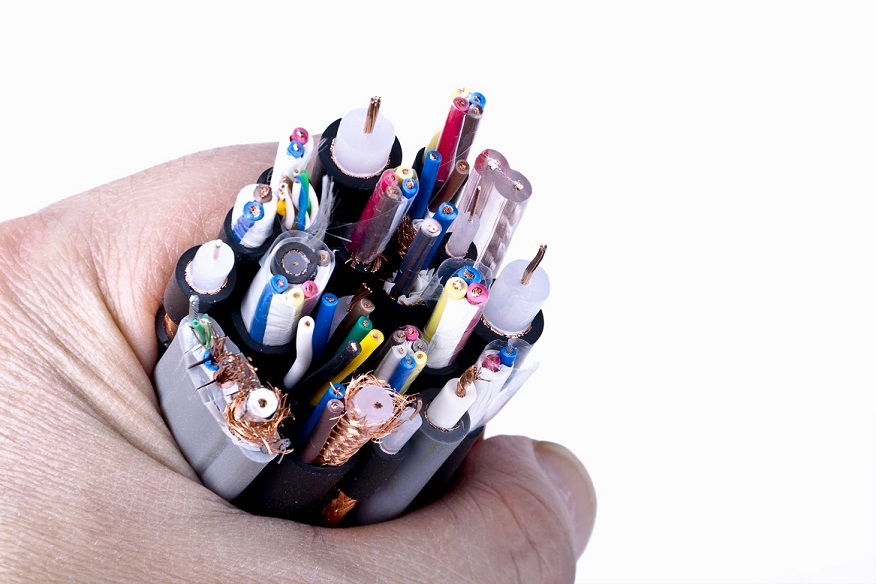Oxygen Free Copper and its Applications
Oxygen free copper is a type of copper that has been refined in an electrically charged solution of copper sulfate and sulfuric acid. This process, called electrolytic refining, causes the copper to have an exceptionally low level of oxygen, often less than one hundredth of a percent.
Commonly used in consumer electronics, oxygen free copper is most frequently found in high end audio-visual systems, though individual oxygen free copper wiring custom cable assemblies are also on the market for the pickiest of music connoisseurs. Oxygen free copper is used for speaker wires, audio/video connector cable assemblies, and amplifier wires because of its purported higher conductivity, and supposedly better ability to transfer low-frequency sounds. Some manufacturers also state that oxygen free copper wiring provides better clarity of sound, and lasts longer than other, less pure, copper wires.
While all of the claims about the good things about oxygen free copper wiring have a degree of truth in them, for most consumers, oxygen free copper wiring is not going to be noticeably different than any other type of copper wiring. The increase in conductivity is minimal, and is not due to the de-oxygenation of the wire. Rather, the process of electrolytic refining also removes other impurities, notably, iron, that can cause resistance. However, even so, the increase in conductivity would not be noticeable unless the wire was extended to a great length, say, over 50 feet. Since no consumer product uses wiring of anything near that length, the increased conductivity is delectably useful at best. In fact, there is no substantial difference between the performance of oxygen free copper and other types of copper in virtually all kinds of consumer products.
Despite its undeservedly high position in the consumer goods market, oxygen free copper does have some applications in very high-tech science equipment, notably, in the construction of magnetometers, electromagnets, and other superconductors. Additionally, oxygen free copper is sometimes used in the manufacture of semiconductors and other high end scientific equipment, such as particle accelerators. In these cases, oxygen free copper is often necessary, as the other components used to manufacture such equipment could have undesired chemical reactions with oxygen.
However, outside of the realm of cutting edge scientific equipment, and extremely advanced copper cable assemblies, oxygen free copper has little practical use, particularly in the consumer world. Though a strong advertising phrase today, it is unlikely to stick around for longer than a few marketing campaigns.
Lean vs Mass Manufacturing: A Very Brief Overview
 “Lean manufacturing” is a favorite buzzword of business conferences lately, and it’s easy for the uninitiated to be unclear on the difference between lean and mass manufacturing. In fact, they differ in many ways, from philosophy and business strategy to production models and company culture.
“Lean manufacturing” is a favorite buzzword of business conferences lately, and it’s easy for the uninitiated to be unclear on the difference between lean and mass manufacturing. In fact, they differ in many ways, from philosophy and business strategy to production models and company culture.
Lean manufacturing works on the principle of “work smarter, not harder,” and works to eliminate production waste; waste being anything that does not add any value to the final product. Common wastes include waiting time, processing, inventory, and leftovers. By eliminating waste, lean manufacturers are usually able to produce higher quality products in a shorter time.
Whereas mass manufacturing is based off of forecasts and sales, lean manufacturing works off of customer orders. This eliminates the need for warehouses, because little excess product is produced. This also keeps the company from having to sell products at a loss when they become obsolete. The most efficient lean manufacturers report more than twenty inventory turnarounds per year; most mass manufacturers report less than ten.
The culture of the two types of companies differs as well. The hierarchy of mass manufacturing companies is inflexible, and usually produces alienation between employees and managers. A lean manufacturing company has a flatter structure, and encourages broad employee participation, which creates a culture of mutual responsibility and open communication. Additionally, in mass manufacturing companies each employee tends to specialize in one area only, and only works on that particular machine or production area, while those in lean companies are widely cross-trained.
Industries that particularly benefit from lean manufacturing are usually those that exist in rapidly evolving markets or those that require a lot of know-how to produce a quality product. Technological manufacturers are one of those most fond of lean manufacturing, as a large inventory of product can quickly turn into a pile of obsolete junk as the industry changes. For example, a custom cable manufacturer could be left with reels of useless wire, or warehouses of out-of-date custom cable assemblies, which would have to be liquidated at a loss. Also, technological industries like cable assembly companies require a high level of skill from their employees to produce quality products, which can become extremely expensive under the specialist system in mass manufacturing.
Though both types of manufacturing produce results, lean manufacturing is considered more forward-thinking, and is becoming increasingly popular, particularly, as stated, in the technology industry. Although more and more companies are converting to lean manufacturing, large companies will continue to rely on mass manufacturing when quality is not a top priority and they can afford a small seasonal loss.
What to Know Before Buying Insulated Wire
From the most basic cable assemblies to intricate custom cable assemblies, insulated wire is found in some form. It’s wide range of uses makes it popular for many kinds of projects, but before you get started, it’s important to do some homework on the wire you plan to buy.
How will it hold up under pressure?
This can encompass a range of issues, but when choosing wiring for a cable assembly, you need to consider what that assembly will go through, and look into the specs of your wiring before you buy. Specific things you should look for include the cable’s optimum temperature range for operation, it’s resistance to water and humidity if it will be in a damp place, and whether it has the flexibility to fit into the type of space you’re working with.

What is its usage rating?
Along with checking how the insulated wire and cable will work in less than ideal conditions, be sure to check how those conditions will affect its usage rating. Every cable is assigned a rating which states the maximum current that can be passed through that wire, along with a maximum temperature for the surface of the conductor. Wires that are commonly used in cable assemblies installed in extreme places, have several ratings, one for its use under ideal circumstances, and one for use in wet places, or places with extreme temperatures. By checking this beforehand you can avoid having to do costly repairs or a full replacement down the road.
What method was used for marking the cable?
This may not seem very important, but the way the cable was marked can make a big difference in its quality. Cables marked by hot stamping are more likely to have damaged insulation or exposed wired due to the pressure on the insulation during the marking. Problems caused by poorly done cable marking are particularly important to look out for when doing large scale cable assembly, when one bad wire can undo a whole lot of work.
Knowing the capacity of your wire before you install it, choosing the right kind of wire for the job, and being able to avoid damage-prone wires makes a huge difference in both basic and custom cable assemblies. If you are unsure of what kind of insulated wire to buy, be sure to consult a professional to avoid expensive repairs or worse, replacements.
*Remember each situation is unique and this is generic information, always consult a professional before making any decision.
Why Outsource?
Outsourcing has become a hot topic in recent years. You may already be aware that the concept of outsourcing is far from a new idea. As far back as 1776, economist and philosopher Adam Smith addressed the topic is his seminal volume An Inquiry into the Nature and Causes of the Wealth of Nations. He has been quoted as saying “If a foreign country can supply us with a commodity cheaper than we ourselves can make it, it is better to buy it of them.”
 In recent years many companies have viewed outsourcing as a business fad or trend to partake in without understanding the true benefits and potential risks that outsourcing can provide their organization. Any manager or executive knows that the effective utilization of organizational resources directly impacts a business’ bottom line. Process improvement, specialization, and task proficiency may not be optimized within your business. If this is the case, you may be able to deliver a better product at a lower cost by outsourcing certain aspects of your business to a firm that can provide these benefits. This enables you to offer your end customer a better product of service and keep your organization focused on what they do best.
In recent years many companies have viewed outsourcing as a business fad or trend to partake in without understanding the true benefits and potential risks that outsourcing can provide their organization. Any manager or executive knows that the effective utilization of organizational resources directly impacts a business’ bottom line. Process improvement, specialization, and task proficiency may not be optimized within your business. If this is the case, you may be able to deliver a better product at a lower cost by outsourcing certain aspects of your business to a firm that can provide these benefits. This enables you to offer your end customer a better product of service and keep your organization focused on what they do best.
For example, if you are located in California and you sell a product primarily in US but do not have the ability to design, manufacture and source materials of the highest quality locally should you settle for what you can do locally and offer your customer a lower quality, higher priced product? Or should you find a company that specializes in the areas you are deficient in, and outsource those functions? That is a business decision you will have to make, however, industry leaders are realizing that everyone wins when companies focus on their core competencies and outsource other functions to a firm who specializes in that area.
Outsourcing non-critical processes to third party firms with more expertise guarantees that your company’s resources are available for critical activities where you do have an expertise. Remember, your partner can supplement your operations and provide additional capacity as needed without the overhead costs your firm would incur if handled on-site. Organizations that outsource often discover that costly infrastructure expenditures are drastically reduced as some functions are outsourced to external locations.
Many successful firms outsource work in order to have their processes delivered by companies with operational expertise in that particular outsourced process. Outsourcing can provide your firm access to exceptional capabilities and infrastructure in terms of the outsourced function. Also, depending on where your firm is located, outsourcing may offer additional incentives both economic and cultural.
Take for example an American firm outsourcing to Canada. Due to the exchange rate, for every dollar an American firm spends in Canada, that firm receives over $1.10 worth of goods and services. Additionally, Canada and the United States share similar cultures and regulatory climates as well as they shares the same aesthetic, quality and core competency values as their American counterparts. The fact that transportation costs and lead times are the same as having a supplier across the other end of state further reflect on the bottom line, and equally quickly. Canada’s cost of labor is lower than the U.S. and Canada has distinctive strategic advantages that firms located elsewhere cannot offer.
Once you assess your business’ strategic needs and begin to select outsourcing vendors, make sure that the firms you consider can accommodate your needs and unique requirements. Outsource correctly and your company will have a competitive advantage over others in your industry.